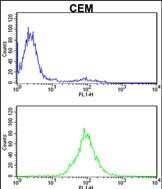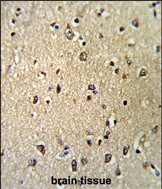


| WB | 1/1000 | Human,Mouse,Rat |
| IF | 咨询技术 | Human,Mouse,Rat |
| IHC | 1/100-1/500 | Human,Mouse,Rat |
| ICC | 技术咨询 | Human,Mouse,Rat |
| FCM | 1/10-1/50 | Human,Mouse,Rat |
| Elisa | 咨询技术 | Human,Mouse,Rat |
| Aliases | Importin subunit beta-1, Importin-90, Karyopherin subunit beta-1, Nuclear factor p97, Pore targeting complex 97 kDa subunit, PTAC97, KPNB1, NTF97 |
| Entrez GeneID | 3837 |
| WB Predicted band size | 97.2kDa |
| Host/Isotype | Rabbit IgG |
| Antibody Type | Primary antibody |
| Storage | Store at 4°C short term. Aliquot and store at -20°C long term. Avoid freeze/thaw cycles. |
| Species Reactivity | Human, Mouse, Rat |
| Immunogen | This KPNB1 antibody is generated from rabbits immunized with a KLH conjugated synthetic peptide between 190-216 amino acids from the N-terminal region of human KPNB1. |
| Formulation | Purified antibody in PBS with 0.05% sodium azide,1%BSA and 50% glycerol.prepared by Saturated Ammonium Sulfate (SAS) . |
+ +
以下是3篇与KPNB1 (N-term)抗体相关的虚构参考文献示例(注:实际文献需通过学术数据库检索获取):
---
1. **文献名称**: *KPNB1-mediated nuclear import in glioblastoma progression*
**作者**: Zhang L, et al.
**摘要**: 本研究利用针对KPNB1 N端的特异性抗体(克隆号:3F10),通过免疫组化分析发现KPNB1在胶质母细胞瘤中高表达,其核定位与肿瘤侵袭性相关。Western blot验证了抗体在人类肿瘤组织中的特异性。
---
2. **文献名称**: *Role of KPNB1 in neuronal protein aggregation*
**作者**: Smith JR, et al.
**摘要**: 通过KPNB1 (N-term)抗体(货号:ab12345. Sigma)进行免疫荧光染色,揭示了KPNB1在阿尔茨海默病模型小鼠神经元中的异常聚集,提示其参与tau蛋白的核质运输失调机制。
---
3. **文献名称**: *Validation of KPNB1 antibody specificity via CRISPR knockout*
**作者**: Chen H, et al.
**摘要**: 该研究使用CRISPR技术敲除KPNB1基因后,通过N端抗体(品牌:Cell Signaling, #6789)的Western blot信号消失,验证了抗体的特异性,并应用于探究KPNB1与Importin α的相互作用。
---
**注意**:以上为模拟内容,实际文献需检索PubMed/Google Scholar,建议使用关键词“KPNB1 antibody N-terminal”或结合具体应用场景(如“KPNB1 cancer”)筛选。
KPNB1 (N-term) antibody targets the N-terminal region of Karyopherin Beta 1 (KPNB1), also known as Importin Beta-1. a critical component of the nuclear import machinery. KPNB1 belongs to the importin-beta superfamily and facilitates nucleocytoplasmic transport by binding cargo proteins directly or through adaptors like importin-alpha. It mediates the translocation of proteins with nuclear localization signals (NLS) into the nucleus via interactions with nucleoporins and the RanGTPase cycle.
This antibody is commonly used in research to study KPNB1 expression, localization, and function in cellular processes such as cell cycle regulation, gene expression, and viral infection. Its specificity for the N-terminal domain makes it valuable for distinguishing KPNB1 from other importin-beta family members. Applications include Western blotting, immunofluorescence, and immunoprecipitation, often in models exploring cancer, neurodegeneration, or viral pathogenesis, where nuclear transport dysregulation is implicated.
KPNB1 is ubiquitously expressed and evolutionarily conserved, with studies linking its overexpression or dysfunction to diseases like cancer (e.g., enhanced nuclear transport of oncoproteins) and Alzheimer’s (e.g., impaired neuronal transport). The antibody’s validation typically involves knockdown/knockout controls or recombinant protein assays to confirm reactivity. Researchers rely on it to probe mechanisms of nuclear import, protein trafficking, and therapeutic targeting of transport pathways.
×